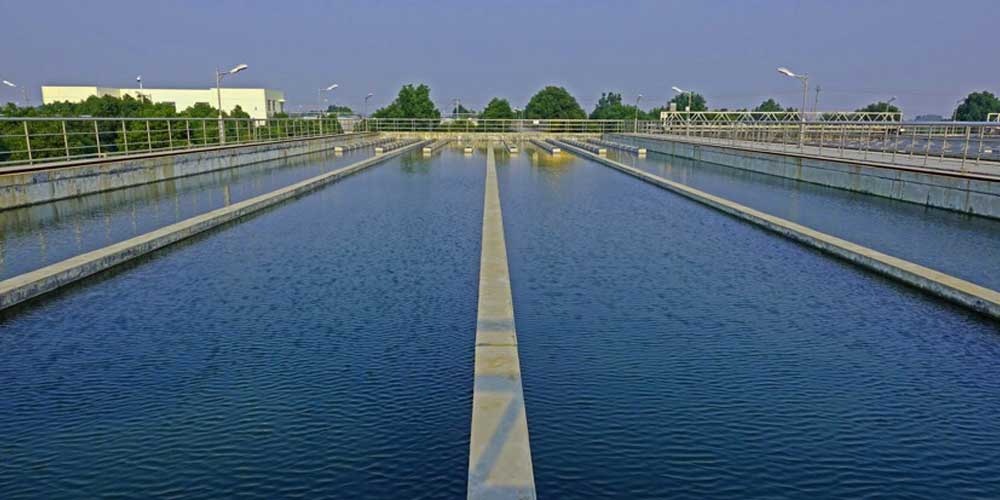پاڻي جي علاج ماحولياتي تحفظ ۽ عوامي صحت جو هڪ اهم حصو آهي، ۽ ان جو مقصد محفوظ پاڻي جي معيار کي يقيني بڻائڻ ۽ مختلف ايپليڪيشنن جي ضرورتن کي پورو ڪرڻ آهي. پاڻي جي علاج جي ڪيترن ئي طريقن مان،پولي ايلومينيم ڪلورائڊ(PAC) کي ان جي منفرد خاصيتن ۽ موثر ڪوئگوليشن اثر جي ڪري وڏي پيماني تي چونڊيو ويندو آهي.
موثر ڪوئگوليشن اثر: پي اي سي ۾ بهترين ڪوئگوليشن ڪارڪردگي آهي ۽ اهو پاڻي ۾ معطل ٿيل سالڊس، ڪولائيڊز ۽ غير حل ٿيندڙ نامياتي مادو جهڙين نجاستن کي مؤثر طريقي سان ختم ڪري سگهي ٿو ۽ پاڻي جي معيار کي بهتر بڻائي سگهي ٿو.
پي اي سي جو ڪوئگوليشن ميڪانيزم
پولي ايلومينيم ڪلورائڊ (PAC) جي ڪوگولنٽ جي طور تي ميڪانيزم ۾ بنيادي طور تي برقي ڊبل پرت جو ڪمپريشن، چارج نيوٽرلائيزيشن ۽ نيٽ ٽريپنگ شامل آهن. ڊبل برقي پرت جي ڪمپريشن جو مطلب آهي ته پاڻي ۾ PAC شامل ڪرڻ کان پوءِ، ايلومينيم آئن ۽ ڪلورائڊ آئن ڪولوائيڊل ذرڙن جي مٿاڇري تي هڪ جذب پرت ٺاهيندا آهن، اهڙي طرح ڪولوائيڊل ذرڙن جي مٿاڇري تي ٻٽي برقي پرت کي دٻائيندا آهن، جنهن جي ڪري اهي غير مستحڪم ۽ ڳنڍجي ويندا آهن؛ جذب پلنگ آهي PAC ماليڪيولز ۾ ڪيٽيشن هڪ ٻئي کي متوجه ڪن ٿا ۽ ڪولوائيڊل ذرڙن جي مٿاڇري تي منفي چارجز، ڪيترن ئي ڪولوائيڊل ذرڙن کي ڳنڍڻ لاءِ هڪ "پل" ڍانچي ٺاهيندا آهن؛ نيٽنگ اثر PAC ماليڪيولز ۽ ڪولوائيڊل ذرڙن جي جذب ۽ پلنگ اثر ذريعي آهي، جيڪو ڪولوائيڊل ذرڙن کي جال بڻائي ٿو. ڪوگولنٽ ماليڪيولز جي نيٽ ورڪ ۾ ڦاسي پيو.
پولي ايلومينيم ڪلورائڊ پاڻي جي علاج جو استعمال
غير نامياتي فلوڪولينٽس جي مقابلي ۾، ان رنگن جي ڊيڪلورائيزيشن اثر کي خاص طور تي بهتر بڻايو آهي. ان جي عمل جو طريقو اهو آهي ته پي اي سي رنگ جي ماليڪيولن کي برقي ڊبل پرت جي ڪمپريشن يا غير جانبداري ذريعي نفيس فلوڪس ٺاهڻ لاءِ فروغ ڏئي سگهي ٿو.
جڏهن PAM کي PAC سان ميلاپ ۾ استعمال ڪيو ويندو آهي، ته اينيونڪ نامياتي پوليمر ماليڪيول پنهنجي ڊگھي ماليڪيولر زنجيرن جي پلنگ اثر کي استعمال ڪندي غير مستحڪم ڪندڙ ايجنٽ جي تعاون سان ٿلها فلوڪس پيدا ڪري سگهن ٿا. هي عمل آباد ڪرڻ واري اثر کي بهتر بنائڻ ۾ مدد ڪري ٿو ۽ ڳري ڌاتو آئن کي هٽائڻ آسان بڻائي ٿو. ان کان علاوه، اينيونڪ پولي ايڪريلامائيڊ ماليڪيول جي پاسي واري زنجيرن ۾ موجود امائيڊ گروپن جي وڏي تعداد رنگ جي ماليڪيولن ۾ -SON سان آئنڪ بانڊ ٺاهي سگهي ٿي. هن ڪيميائي بانڊ جي ٺهڻ سان پاڻي ۾ نامياتي فلوڪولينٽ جي حل پذيري گهٽجي ٿي، ان ڪري فلوڪس جي تيزيءَ سان ٺهڻ ۽ ورن کي فروغ ملي ٿو. هي گہرا پابند ڪرڻ وارو طريقو ڳري ڌاتو آئنن لاءِ فرار ٿيڻ کي وڌيڪ ڏکيو بڻائي ٿو، علاج جي ڪارڪردگي ۽ اثر کي بهتر بڻائي ٿو.
فاسفورس جي خاتمي جي لحاظ کان، پولي ايلومينيم ڪلورائڊ جي اثرائتي کي نظرانداز نٿو ڪري سگهجي. جڏهن فاسفورس تي مشتمل گندي پاڻي ۾ شامل ڪيو ويندو آهي، ته اهو ٽرائي ويلنٽ ايلومينيم ڌاتو آئن پيدا ڪرڻ لاءِ هائيڊولائيز ڪري سگهي ٿو. هي آئن گندي پاڻي ۾ حل ٿيندڙ فاسفيٽس سان ڳنڍيل آهي، بعد ۾ ان کي غير حل ٿيندڙ فاسفيٽ پرسيپيٽيٽس ۾ تبديل ڪري ٿو. هي تبديلي جو عمل گندي پاڻي مان فاسفيٽ آئن کي مؤثر طريقي سان هٽائي ٿو ۽ پاڻي جي جسمن تي فاسفورس جي منفي اثر کي گهٽائي ٿو.
فاسفيٽ سان سڌي رد عمل کان علاوه، پولي ايلومينيم ڪلورائڊ جو ڪوئگوليشن اثر پڻ فاسفورس کي ختم ڪرڻ جي عمل ۾ اهم ڪردار ادا ڪري ٿو. اهو فاسفيٽ آئنز جي مٿاڇري تي چارج پرت کي دٻائي جذب ۽ پل حاصل ڪري سگهي ٿو. اهو عمل گندي پاڻي ۾ فاسفيٽ ۽ ٻين نامياتي آلودگي کي جلدي ڪلپس ۾ گڏ ڪرڻ جو سبب بڻائيندو آهي، جيڪي فلوڪس ٺاهيندا آهن جيڪي آباد ٿيڻ ۾ آسان آهن.
وڌيڪ اهم ڳالهه اها آهي ته، فاسفورس هٽائڻ واري ايجنٽ کي شامل ڪرڻ کان پوءِ پيدا ٿيندڙ باریک دانے دار معطل ٿيل ٺوس شين لاءِ، پي اي سي پنهنجي منفرد نيٽ ڪيچنگ ميڪانيزم ۽ مضبوط چارج نيوٽرلائيزيشن اثر کي استعمال ڪري ٿو ته جيئن انهن معطل ٿيل ٺوس شين جي بتدريج واڌ ۽ ٿلهي ٿيڻ کي فروغ ڏئي سگهجي، ۽ پوءِ وڏن ذرڙن ۾ ڳرڻ، گڏ ڪرڻ ۽ فلوڪليٽ ٿئي. اهي ذرڙا پوءِ هيٺئين پرت تي آباد ٿين ٿا، ۽ ٺوس-مائع جي علحدگي ذريعي، سپرنيٽينٽ مائع کي خارج ڪري سگهجي ٿو، جنهن سان فاسفورس کي موثر طور تي ختم ڪرڻ حاصل ٿئي ٿو. پيچيده جسماني ۽ ڪيميائي عملن جو هي سلسلو گندي پاڻي جي علاج جي ڪارڪردگي ۽ استحڪام کي يقيني بڻائي ٿو، ماحولياتي تحفظ ۽ پاڻي جي وسيلن جي ٻيهر استعمال لاءِ هڪ مضبوط ضمانت فراهم ڪري ٿو.
پوسٽ جو وقت: جولاءِ-10-2024


